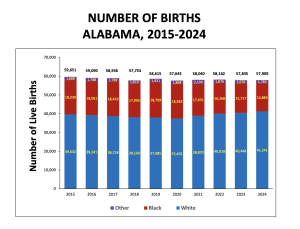Alabama’s infant mortality rate dipped in 2024 – Alabama Daily News

Report on Infant Mortality in Alabama and Alignment with Sustainable Development Goals (SDGs)
Overview of 2024 Infant Mortality Data
In 2024, the state of Alabama recorded a decrease in its infant mortality rate to 7.1 deaths per 1,000 live births, an improvement from the 7.8 rate reported in 2023. This rate corresponds to 414 infant deaths within their first year. Despite this progress, Alabama’s rate remains significantly higher than the national average of 5.5 and has not returned to the state’s historic low of 6.7 recorded in 2022. These statistics highlight ongoing challenges in achieving key targets within the Sustainable Development Goals, particularly SDG 3 (Good Health and Well-being).
Key Findings and Progress Indicators
- Infant Mortality Rate: 7.1 per 1,000 births in 2024.
- Prenatal Care Access: A decline in adequate prenatal care was observed, dropping from 74.7% in 2023 to 73.9% in 2024. Concurrently, the percentage of births with no prenatal care increased from 2.6% to 3.1%. This trend directly impacts the objectives of SDG 3.
- Positive Social Indicators:
- Teen births reached a historic low of 5.8%.
- Births to mothers who smoke decreased to 3.3%.
Analysis of Disparities and Contributing Factors in the Context of SDGs
SDG 3: Good Health and Well-being
The primary causes of infant death in Alabama present significant obstacles to achieving SDG Target 3.2, which aims to end preventable deaths of newborns and children under five. The leading causes in 2024 were:
- Congenital malformations, deformations, and abnormalities (21.5%)
- Disorders related to short gestation and low birth weight (15.9%)
- Bacterial sepsis of newborn (5.1%)
- Unintentional injuries (4.1%)
- Sudden Infant Death Syndrome (SIDS) (3.4%)
The improvement in SIDS, moving from the third to the fifth leading cause of death, marks positive progress. However, maternal health conditions such as diabetes and hypertension are noted as contributing factors to preterm births, underscoring the importance of addressing SDG Target 3.1 (reduce the global maternal mortality ratio).
SDG 10: Reduced Inequalities
Significant disparities persist, directly challenging the core principles of SDG 10. Analysis reveals deep-seated inequalities based on race and economic status.
- Racial Disparity: The infant mortality rate for Black infants was 11.4 per 1,000 births, more than double the rate for white infants, which stood at 5.4. This stark gap highlights a failure to ensure equal health outcomes as mandated by SDG Target 10.3.
- Economic Disparity: Medicaid covered 42% of births in 2024; however, 55% of all infant deaths occurred among mothers whose deliveries were paid for by Medicaid. This indicates a strong correlation between lower economic status and adverse birth outcomes, linking directly to SDG 1 (No Poverty).
Socioeconomic Determinants (SDG 1, 4, 5, 11)
State Health Officer Dr. Scott Harris identified several socioeconomic factors that contribute to infant mortality, reflecting an intersection of multiple SDGs. These include poverty (SDG 1), education (SDG 4), housing (SDG 11), nutrition, and access to care. Addressing these root causes is essential for creating a sustainable environment for maternal and child health and achieving gender equality (SDG 5) through improved health outcomes for women.
State-Level Interventions to Advance SDG Targets
The Alabama Department of Public Health (ADPH) has implemented several programs aimed at mitigating these issues and advancing progress toward the SDGs.
- Improving Healthcare Access (SDG 3 & 10): In rural counties, ADPH is collaborating with providers to offer telehealth prenatal services, extending care to low-risk women up to 36 weeks of pregnancy. This initiative directly addresses barriers to healthcare access.
- Promoting Women’s Health (SDG 3 & 5): The Well Woman Program, available in 11 counties, encourages healthy living and disease prevention for women aged 15 to 55, fostering healthier pregnancies and contributing to gender equality in health.
- Expanding Insurance Coverage (SDG 1 & 10): The ALL Babies program has expanded statewide to provide coverage for pregnant women who meet income guidelines but lack other insurance, directly targeting economic barriers to care.
Dr. Harris expressed hope that “by following evidence-based practices, we will save lives,” indicating a commitment to strategies that can accelerate progress toward achieving the Sustainable Development Goals for health and equality in Alabama.
Analysis of SDGs, Targets, and Indicators
1. Which SDGs are addressed or connected to the issues highlighted in the article?
-
SDG 3: Good Health and Well-being
This is the most prominent SDG in the article. The entire text focuses on public health issues, specifically infant mortality rates in Alabama. It discusses the causes of infant death, maternal health conditions, and access to healthcare services like prenatal care, all of which are central to SDG 3.
-
SDG 10: Reduced Inequalities
The article explicitly highlights significant disparities in health outcomes based on race. It states, “Racial disparities remain in birth outcomes; the Black infant mortality rate is more than twice the rate for white infants.” This direct comparison of mortality rates between different racial groups connects the article’s content to the goal of reducing inequalities.
2. What specific targets under those SDGs can be identified based on the article’s content?
-
Target 3.2: End preventable deaths of newborns and children under 5
The article’s primary focus is the infant mortality rate, which is defined as “deaths within the first year of their life.” This directly relates to Target 3.2, which aims to end preventable deaths of newborns and children under five. The article provides specific data on the decline of this rate in Alabama and lists the leading causes of these deaths, such as congenital malformations and low birth weight.
-
Target 3.8: Achieve universal health coverage
This target is relevant because the article discusses access to healthcare services, a key component of universal health coverage. It mentions that the “percentage of births with adequate prenatal care dipped” and the “percentage of births with no prenatal care rose.” Furthermore, it highlights programs designed to improve access for low-income women and those in rural counties, such as telehealth services and the ALL Babies program for the uninsured, which are efforts toward achieving universal health coverage.
-
Target 10.2: Promote the social inclusion of all, irrespective of race
The article’s data reveals a significant inequality of outcome based on race. By stating that the infant mortality rate for Black babies (11.4) is more than double that for white babies (5.4), it highlights a lack of equal health outcomes. This disparity points directly to the challenge of ensuring that all individuals, regardless of race, have an equal opportunity to thrive, which is the essence of Target 10.2.
3. Are there any indicators mentioned or implied in the article that can be used to measure progress towards the identified targets?
-
Infant Mortality Rate (Indicator for Target 3.2)
The article provides precise data for this indicator. It states the overall infant mortality rate for Alabama in 2024 is “7.1 deaths per 1,000 births.” This is a direct measure used to track progress on reducing child mortality.
-
Disaggregated Infant Mortality Rate by Race (Indicator for Target 10.2)
To measure inequality, data must be broken down by demographic groups. The article provides this by stating, “The rate of infant deaths among black babies decreased in 2024 to 11.4, but remains higher than the rate of white babies, 5.4.” This disaggregated data serves as a direct indicator of health inequality between racial groups.
-
Coverage of Essential Health Services (Indicator for Target 3.8)
The article implies this indicator by providing data on prenatal care, which is an essential health service for pregnant women. It specifies that “The percentage of births with adequate prenatal care dipped from 74.7% in 2023 to 73.9% last year” and “The percentage of births with no prenatal care rose from 2.6% in 2023 to 3.1% in 2024.” These percentages are direct measures of access to and utilization of a critical health service.
4. Create a table with three columns titled ‘SDGs, Targets and Indicators” to present the findings from analyzing the article.
| SDGs | Targets | Indicators |
|---|---|---|
| SDG 3: Good Health and Well-being | Target 3.2: End preventable deaths of newborns and children under 5 | Infant mortality rate (7.1 deaths per 1,000 births in 2024) |
| SDG 3: Good Health and Well-being | Target 3.8: Achieve universal health coverage | Percentage of births with adequate prenatal care (73.9% in 2024) and percentage with no prenatal care (3.1% in 2024) |
| SDG 10: Reduced Inequalities | Target 10.2: Promote the social inclusion of all, irrespective of race | Infant mortality rate disaggregated by race (11.4 for Black infants vs. 5.4 for white infants in 2024) |
Source: aldailynews.com
What is Your Reaction?
 Like
0
Like
0
 Dislike
0
Dislike
0
 Love
0
Love
0
 Funny
0
Funny
0
 Angry
0
Angry
0
 Sad
0
Sad
0
 Wow
0
Wow
0
















































:focal(1500,1000)/https://media.globalcitizen.org/a6/9a/a69a4720-d8a1-4715-b596-18738d03c05c/rotary_polio_hero_image.jpg?#)







/countries/sri-lanka/photo-credit---dmc-sri-lanka.tmb-1200v.jpg?sfvrsn=dc298bcc_1#)


















